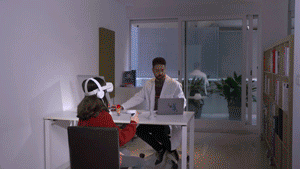In the field of neuropsychological assessment, objectivity is key to obtaining accurate diagnoses and designing effective interventions. However, until now, most methodologies have relied on questionnaires and guided exercises, which means that assessments have been influenced by the professional conducting the assessment. This is known as “evaluator bias”, and mental health professionals have long struggled with this inherent limitation of conventional diagnostic methods. Now, virtual reality is emerging as a transformative tool: it minimizes evaluator bias and also ensures high validity in the results.
🔵 Goal: to eliminate subjectivity in assessment in order to keep moving toward diagnoses that are as tailored as possible to each individual patient.
Understanding Evaluator Bias
Evaluator bias is a distortion that occurs when a professional’s expectations, beliefs, or prior experiences influence the interpretation of test results. Until recently, assessments relied heavily on the professional’s interpretation, with their unconscious predispositions and personal background always present.
In addition, there are three other key limitations to consider:
– The evaluator may, without realizing it, steer the patient toward certain responses.
– Conventional assessments take place in artificial settings (clinical environments that do not reflect the patient’s everyday life).
– The same set of results could be interpreted differently by different professionals, compromising diagnostic objectivity.
This bias not only affects the accuracy of the diagnosis, but can also significantly influence:
– The evaluator’s perception of the patient’s performance
– The intervention recommendations
– The resulting therapeutic plan
Virtual Reality as a New Diagnostic Paradigm
Virtual reality emerges as a technological solution that overcomes these assessment limitations. By creating controlled, standardized environments free from subjective influence, these tools ensure a more accurate evaluation — and therefore, a therapeutic plan that is better tailored to the patient’s real needs.
Ecological Validity: Looking Beyond the Clinic
A key concept in this virtual reality revolution is ecological validity. Neuropsychological assessment using virtual reality makes it possible to simulate situations that closely resemble the patient’s everyday life. As a result, cognitive performance is captured in contexts that go beyond artificial or decontextualized testing environments.
Nesplora Attention Kids Aula: Leading Innovation in Neuropsychological Evaluation
The Nesplora Attention Kids Aula test is a Continuous Performance Test (CPT) conducted through virtual reality goggles and headphones. The participant receives instructions and responds to various stimuli by pressing a button. The stimuli can be either visual or auditory—never both at the same time—which allows for the analysis of attention across different sensory channels. 
Virtual Reality Assessment: Key Advantages
- Elimination of evaluator bias: the system records objective data without requiring the evaluator’s direct interpretation.
- Standardization: each patient experiences exactly the same environment and stimuli as others.
- Diagnostic precision: greater ability to detect subtle differences in cognitive performance.
- Patient motivation: these interactive environments improve engagement during the assessment.
The Present and Future of Neuropsychological Assessment
Virtual reality is not a passing trend, but the present and future of neuropsychological assessment. By eliminating evaluator bias, these tools are democratizing diagnosis and enabling the design of more precise and personalized interventions. As neuropsychology professionals, we believe it is essential to pursue diagnostic excellence—and right now, virtual reality represents much more than just a technology: it is a new way of understanding and approaching neuropsychological assessment.
You might also find this interesting…

You may not be a healthcare professional, but you suspect that you—or someone close to you—could benefit from a better understanding of executive functioning. If that’s the case, we encourage you to find the nearest specialist in our international network of professionals who use Nesplora.
If you are a mental health professional and have any questions, feel free to contact us at customers@nesplora.com—we’ll be happy to get in touch.
Follow us on Facebook, Twitter, Instagram, LinkedIn & YouTube for more content on neuropsychology, virtual reality and clinical practice, cognitive processes, education and mental health.